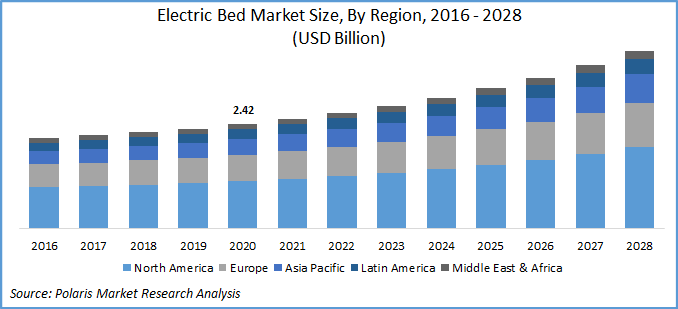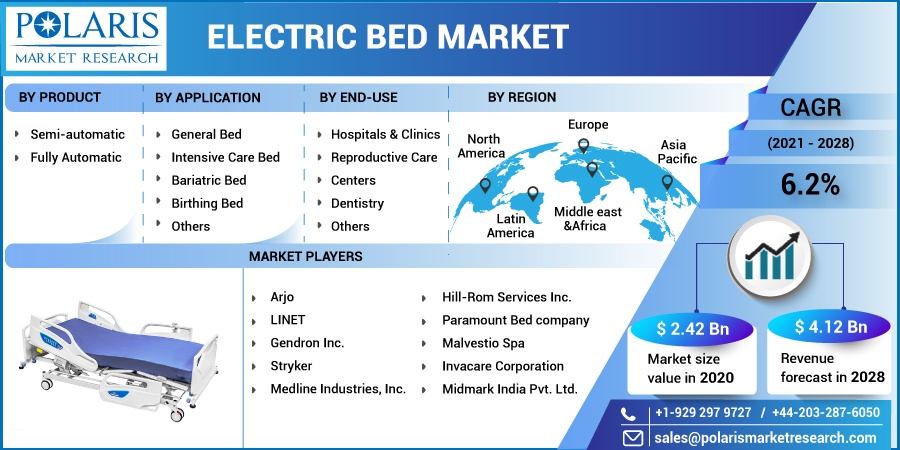
Electric Bed Market Share, Size, Trends, Industry Analysis Report, By Product (Semi-automatic, Fully Automatic), By Application (General Bed, Intensive Care Bed, Bariatric Bed, Birthing Bed), By End-Use (Hospitals & Clinics, Reproductive Care Centers, Dentistry, Others); Segment Forecast, 2021 - 2028
- Published Date:Feb-2021
- Pages: 103
- Format: PDF
- Report ID: PM1797
- Base Year: 2020
- Historical Data: 2016 - 2019
Report Outlook
The global electric bed market was valued at USD 2.42 billion in 2020 and is expected to grow at a CAGR of 6.2% during the forecast period. Prominent factors responsible for the market growth include rising hospital admissions across the globe due to road traffic injuries, the surge in infectious disease, and other disorders of the patients coupled with rising disposable income in the low-income countries. Moreover, the recent outbreak of COVID-19 and the rising geriatric population also has increased patient admissions. Several conditions require extra care such as comfort with improved blood circulations for the patient.
Industry Dynamics
Growth Drivers
Global aging population over 60 years, all over the world have stimulated the adoption of electric cots. Old age people have lower immunity and are more prone to cardiac problems, skeletal injuries, neurological diseases, and spinal disorders are projected to be high impact factor for electric bed industry growth over the projected period.

Know more about this report: request for sample pages
According to the estimates of the WHO, worldwide, by 2050, there would be around 1.5 billion people aged over 65 or older. Geriatrics people are highly susceptible to diseases such as heart attacks, obesity, stroke, and arthritis. Patients suffering from such a disease require an electric cot for more comfort and ease of treatment. Hence, the growing old age population is likely to fuel electric bed industry growth.
The rising number of surgeries is also expected to drive the market forward. According to the estimates of the Molnlycke Health Care AB, each year in Europe around 70 million surgeries were performed and Healthcare Cost and Utilization Project (HCUP) estimated that in 2015, in the U.S. alone there were more than 9,942,000 surgeries performed in the ambulatory care settings. Surgical procedures require an electric cot in all the healthcare facilities. Hence, such instances are projected to fuel the market growth.

Know more about this report: request for sample pages
Electric Bed Market Report Scope
The electric bed market is primarily segmented on the basis of product, by application, by end-use, and geographic region.
|
By Product |
By Application |
By End Use |
By Region |
|
|
|
|
Know more about this report: request for sample pages
Insight by Product
Based upon the product, the global electric bed industry is bifurcated into semi-automatic, and fully automatic electric cots. In 2020, the semi-automatic segment had the largest market share. This high growth is attributed to rising cases of cancer across the globe and the recent surge in infectious diseases over the past decade. According to the study published by the World Health Organization in 2018, there were more than 2.1 million registered cases of lung cancer, and 1.8 million cases of colorectal cancer, globally.
Hence, rising patient admissions in the hospitals and clinics are likely to propel the market segment growth forward. A fully automatic electric bed segment is projected to register lucrative market growth over the forecast period. The rapid adoption of the product is owing to its benefits. Such beds allow patients to have improved sleep and can be handled without any outside assistance.
Insight by Application
Based on application, the global electric bed industry is bifurcated into general, intensive care, bariatric, birthing, and other cots. In 2020, the general bed segment accounted for the largest market share. This cot allows the patient to adjust body positions according to its comfort, and the recent surge in COVID-19 cases all over the world have propelled the adoption of the product. Moreover, the rising old age people requiring home and long-term care also fueling the segment growth.
The intensive care market segment is expected to register lucrative growth over the study period. The global rise in sports-related injuries and accidents and consequent surgeries in the intensive care units impacting the adoption of electric cots in the ICUs. As per the statistics published by the Association for Safe International Road Travel (ASIRT), each year more than 35 million people get disabled. In the U.S. alone, around 37,000 people die due to road traffic accidents each year and more than 2.3 million were disabled.
Insight by End-Use
Based on end-use, the global electric bed industry is bifurcated into hospitals & clinics, reproductive care centers, dentistry, and others. In 2020, the hospitals & clinics segment accounted for the largest market share. Rising cases of chronic wounds and hospital admissions are the factors contributing to electric cots market growth.
Moreover, the increasing number of surgeries has also impacted the segment’s growth positively. However, the reproductive care market segment is projected to register lucrative market growth over the assessment period. Comfort and convenience offered by such cots help the patient in the comfortable delivery.
Geographic Overview
Geographically, North America electric bed industry is the largest contributor to sales in the global market. Regional factors responsible for the market growth include rising surgical procedures and hospital admissions, and technological innovations by market players to increase patient safety and comfort through modifications. Moreover, the recent surge in COVID-19 patients also boosted the demand for the cots.
As a consequence, respective governments projected to invest more than USD 265 million on personal protective, including isolation beds. With the continuous rise in the COVID-19 cases in North America the demand for the isolation bed is projected to rise in the short term. The region registered more than 18,763 deaths as of the first week of April 2020.
Asia Pacific electric bed industry is projected to register lucrative growth over the assessment period. Increasing medical infrastructure, rising disposable income, and the presence of a large pool of population present in India, Japan, and China fueled the segment’s growth prospects. Moreover, the emergence of privately operating hospital chains in the South Asian countries also projected to the adoption of electric cots in the region.
Competitive Insight
The key players operating in the global market are Arjo, Medline Industries, Inc., Hill-Rom Services Inc., Paramount Bed company, Gendron Inc., Stryker, Malvestio Spa, Invacare Corporation, LINET, and Midmark India Pvt. Ltd.
